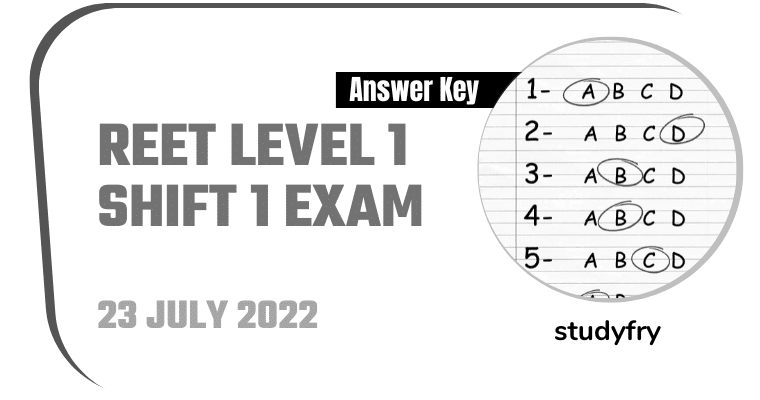21. Repeatedly asking children to engage in learning activities either to avoid punishment or to gain a reward will
(A) Decrease extrinsic motivation
(B) Increase intrinsic motivation
(C) Would encourage children to focus on mastery rather than performance goals.
(D) Decrease children’s natural interest and curiosity involved in learning.
बार-बार बच्चों को सजा से बचने या इनाम पाने के लिए सीखने की गतिविधियों में संलग्न होने के लिए कहना क्या दर्शाता है ?
(A) उनकी बाहरी प्रेरणा को कम करता है ।
(B) उनकी आन्तरिक प्रेरणा को बढ़ाता है ।
(C) बच्चों को लक्ष्य प्रदर्शन की बजाय महारथ हासिल करने के प्रति ध्यान केन्द्रित करने के लिए प्रोत्साहित करता है।
Show Answer
Hide Answer
22. According to RTE Act, 2009 working hours per week for teachers are
(A) 40 hours
(B) 42 hours
(C) 45 hours
(D) 48 hours
आर.टी.ई. अधिनियम, 2009 के अनुसार शिक्षकों के लिए प्रति सप्ताह काम के निर्धारित घंटे हैं
(A) 40 घंटे
(B) 42 घंटे
(C) 45 घंटे
(D) 48 घंटे
Show Answer
Hide Answer
23. Which among the following is different from the characteristics of a Good test ?
(A) Reliability
(B) Validity
(C) Objectivity
(D) Aptitude
निम्न में से कौन सा एक उत्तम परीक्षण की विशेषताओं से भिन्न है ?
(A) विश्वसनीयता
(B) वैधता
(C) वस्तुनिष्ठता
(D) अभिक्षमता
Show Answer
Hide Answer
24. Which of the following is most important in learner centered curriculum ?
(A) Teacher
(B) Child
(C) Contents
(D) Environment
शिक्षार्थी केंद्रित पाठ्यक्रम में निम्नलिखित में से कौन सबसे महत्त्वपूर्ण है ?
(A) अध्यापक
(B) बच्चा
(C) विषयवस्तु
(D) वातावरण
Show Answer
Hide Answer
25. A Reflective teacher creates classroom situations for students to
(A) Listening the lecture.
(B) Taking notes from the lecture of the teacher.
(C) Maintaining classroom discipline.
(D) Promoting interaction between students and the teacher.
एक चिन्तनशील शिक्षक कक्षा-कक्ष में ऐसी परिस्थिति उत्पन्न करता है कि छात्र
(A) व्याख्यान सुन सकें।
(B) कक्षा-कक्ष में शिक्षक के व्याख्यान के नोट्स ले सकें।
(C) कक्षा-कक्ष में अनुशासन बनाये रखें ।
(D) छात्रों और शिक्षक में पारस्परिक अन्तःक्रिया को प्रोत्साहन मिलें ।
Show Answer
Hide Answer
26. Action research means
(A) A longitude research.
(B) An applied research.
(C) A research initiated to solve an immediate problem.
(D) A research with socio-economic objective.
क्रियात्मक अनुसंधान का अर्थ है
(A) एक अनुदैर्ध्य अनुसंधान ।
(B) एक अनुप्रयुक्त अनुसंधान ।
(C) एक शोध जिससे तत्काल समस्या को हल किया जा सके।
(D) सामाजिक-आर्थिक उद्देश्य के साथ एक शोध ।
Show Answer
Hide Answer
27. According to NCF 2005, the role of a teacher has to be
(A) Permissive
(B) Facilitator
(C) Authoritative
(D) Dictatorial
NCF 2005 के अनुसार, एक शिक्षक की भूमिका होनी चाहिए
(A) अनुमोदक
(B) सुविधादाता
(C) आधिकारिक
(D) तानाशाह
Show Answer
Hide Answer
28. The purpose of evaluation is
(A) To label children as slow learner and gifted children.
(B) To identify children who need remedial measures.
(C) To diagnose learning difficulties and problem areas.
(D) To provide feedback on the extent to which we have been successful in imparting education for a productive life.
मूल्यांकन का उद्देश्य क्या होता है ?
(A) बच्चों को मंद शिक्षार्थी और प्रतिभाशाली बच्चों के रूप में अंकित करने के लिए ।
(B) उन बच्चों की पहचान करने के लिए जिन्हें उपचारी उपाय की आवश्यकता है।
(C) सीखने की कठिनाइयों और समस्या क्षेत्रों का निदान करने के लिए।
(D) उस सीमा तक प्रतिपुष्टि प्रदान करना जहाँ तक हम उत्पादनशील जीवन के लिए शिक्षा प्रदान करने में सफल रहे है।
Show Answer
Hide Answer
29. Match the following Principles of Development with their correct description :
Name of Principle of Development – Description of Principle
(1) Proximodistal trend (a) Head to Toe Sequence
(2) Cephalo-caudal trend (b) Different children develop at different rates
(3) Inter-individual Differences (c) In a single child, the rate of development can vary from one domain of development to the other
(4) Intra-individual Differences (d) Growth from the Centre of body to outwards
(1) (2) (3) (4)
(A) (d) (a) (b) (c)
(B) (a) (b) (c) (d)
(C) (c) (d) (b) (a)
(D) (d) (b) (a) (c)
निम्नलिखित विकास के सिद्धान्तों का उनके सही वर्णन से मिलान कीजिए :
विकास के सिद्धान्त का नाम – सिद्धान्त का वर्णन
(1) समीप – दूराभिमुख दिशा (a) सिर से पैर का क्रम
(2) सिर – पदाभिमुख दिशा (b) विभिन्न बच्चे भिन्न-भिन्न दर से बढ़ते हैं।
(3) अंतर्वैयक्तिक भिन्नताएँ (c) किसी एक बच्चे में विकास की दर, विकास के एक क्षेत्र की अपेक्षा दूसरे से भिन्न हो सकती है।
(4) अंतरावैयक्तिक भिन्नताएँ (d) शरीर के केन्द्र से बाहर की ओर वृद्धि
(1) (2) (3) (4)
(A) (d) (a) (b) (c)
(B) (a) (b) (c) (d)
(C) (c) (d) (b) (a)
(D) (d) (b) (a) (c)
Show Answer
Hide Answer
30. Development proceeds from ____ to ____.
(A) General – Specific
(C) Specific – General
(B) Complex – Hard
(D) Simple – Easy
विकास ____ से _____ की ओर बढ़ता है।
(B) जटिल – कठिन
(A) सामान्य – विशिष्ट
(C) विशिष्ट – सामान्य
(D) साधारण – आसान
Show Answer
Hide Answer
